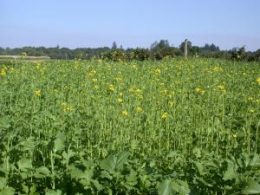 Too often producers do not notice mustard weeds in their wheat fields until the mustards start to bloom in the spring. As a result, producers often don’t think about control until that time. Although it is still possible to get some control at that time with herbicides, mustards are much more difficult to control at that stage and often have already reduced wheat yields by then.
Too often producers do not notice mustard weeds in their wheat fields until the mustards start to bloom in the spring. As a result, producers often don’t think about control until that time. Although it is still possible to get some control at that time with herbicides, mustards are much more difficult to control at that stage and often have already reduced wheat yields by then.
To keep yield losses to a minimum, mustards should be controlled by late winter or very early spring, before the plants begin to bolt, or stems elongate. If winter annual broadleaf weeds are present in the fall, they can be controlled with any number of ALS-inhibiting herbicides, including Ally, Amber, Finesse, Affinity, Rave, Olympus, or PowerFlex. Huskie, Quelex, 2,4-D, and MCPA can also provide good control of most mustards if the weeds are at the right stage of growth and actively growing, and if the wheat is at the correct growth stage. Dicamba and Starane are not very effective for mustard control.
In the late winter or early spring, blue mustard is perhaps the most difficult of the winter annual broadleaf weeds to control because it bolts very early. To be effective on blue mustard, herbicides typically need to be applied in late February or early March. Blue mustard is more difficult to control than tansy mustard with 2,4-D because blue mustard has often already bolted by the time 2,4-D can be safely applied to wheat. Thus, 2,4-D often is applied too late to be effective on blue mustard.
Quelex is a new product from Dow AgroSciences that is a premix of a short-lived ALS herbicide and a new auxin-type herbicide called halauxifen. It generally can provide good control of most mustard species. Quelex can be applied from the 2-leaf up to flag leaf emergence growth stages of wheat and should be applied in combination with nonionic surfactant or oil concentrate for control of small, actively growing weeds. If ALS-resistant weeds are present, Quelex alone may not be effective.
Some producers commonly apply ALS herbicides with fertilizer in January or February. Unfortunately, MCPA, 2,4-D, and Huskie are most effective when applied to actively growing weeds, so application when weeds are dormant may not provide good control. As a result, if an ALS-inhibitor tank-mix with one of these herbicides is applied to dormant ALS-resistant mustards in the winter, poor control could occur. ALS-resistant bushy wallflower seems to be present in a number of fields in central Kansas. ALS-resistant flixweed has only been confirmed in the Saline county area, but may start to show up elsewhere. Producers should watch for cases of poor control, and consider alternative herbicides or herbicide tank-mixes to help prevent or manage ALS-resistant weeds.
Crop rotation with corn, grain sorghum, soybeans, cotton, or sunflowers is a good way of managing mustards as long as they are controlled in the spring prior to producing seed. Crop rotation will usually result in a gradual reduction of mustard populations in the future as the seedbank in the soil gradually decreases.
